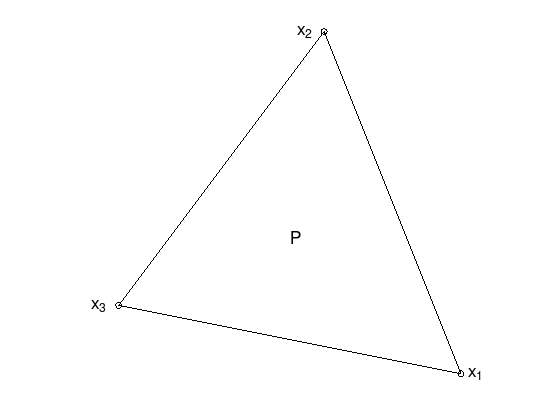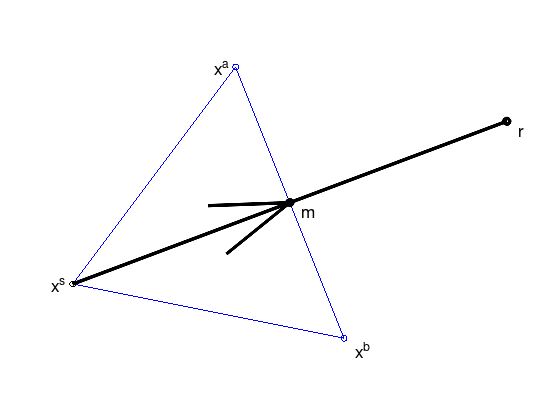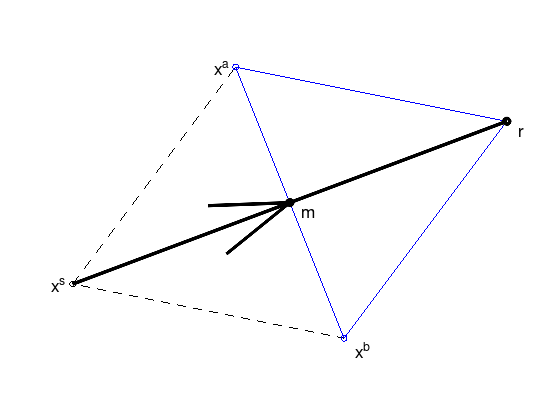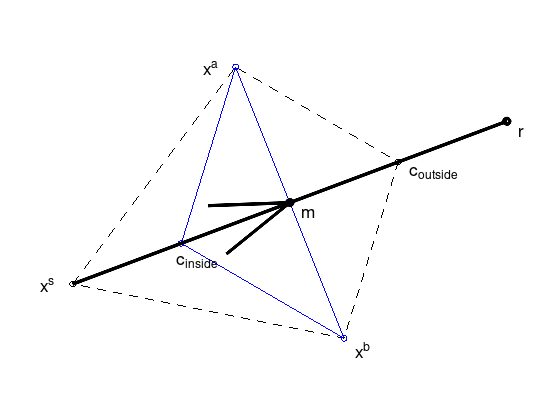Nelder–Mead method
Contents
Nelder–Mead method#
In the previous subsection, the gradient methods require the objective function to be once or twice continously differentiable.
The Nelder–Mead method [NM65] described in this subsection, requires the objective function to be continous only. Therefore it is an example of a derivative-free optimization method.
This method is implemented in the Matlab/Octave function
fminsearch.
See [LRWW98] and [PCB02] for modifications
and references.
Basic concept of this method is a simplex (polyhedron), here defined as a set of \(n + 1\) linear independent points \(P = \{ x_1, x_2, \ldots, x_{n + 1} \} \subset \mathbb{R}^{n}\) (the vertices of the simplex).
In geometry the convex hull of \(P\) is usually defined as simplex. For dimension \(n = 2\), the simplex is a non-degenerate triangle, as in the following figure. For dimension \(n = 3\), a non-degenerate tetrahedron.
x1 = [ 0.0, 0.0];
x2 = [-0.4, 1.0];
x3 = [-1.0, 0.2];
x = [x1; x2; x3; x1];
x_label = {'x_1', 'x_2', 'x_3'};
plot (x(:,1), x(:,2), 'ko-');
hold on;
tprops = {'FontSize', 18};
for i = 1:3
if (x(i,1) < 0)
x_offset = -0.08;
else
x_offset = 0.02;
end
text (x(i,1) + x_offset, x(i,2), x_label{i}, tprops{:});
end
text (-0.5, 0.4, 'P', tprops{:});
axis equal;
axis off;

Iteration step of the simplex method (\(n \geq 2\))#
Compute the following indices \(s, a, b \in \{ 1, \ldots, n + 1 \}\):
\(x^{s} := \operatorname{argmax} \{ f(x) \colon x \in P \}\) (worst point)
\(x^{a} := \operatorname{argmax} \{ f(x) \colon x \in P, a \neq s \}\) (second worst point)
\(x^{b} := \operatorname{argmin} \{ f(x) \colon x \in P, b \neq s, b \neq a \}\) (best point)
Compute the centroid \(m\) of the \(n\) best points
\[\begin{split} m := \frac{1}{n} \sum_{\substack{i = 0 \\ i \neq s}}^{n + 1} x^i, \end{split}\]and the point \(r\) reflected at the center \(m\)
\[ r := m + \alpha (m - x^s), \]with \(\alpha = 1\).
function plot_line (points, LineSpec)
plot (points(:,1), points(:,2), LineSpec{:});
end
function plot_triangle (points, LineSpec)
% Repeat first point.
plot_line ([points; points(1,:)], LineSpec);
end
xb = [ 0.0, 0.0];
xa = [-0.4, 1.0];
xs = [-1.0, 0.2];
m = xb + 0.5 * (xa - xb);
r = m + (m - xs);
points = [xb; xa; xs; m; r];
plabel = {'x^b', 'x^a', 'x^s', 'm', 'r'};
plot_triangle ([xb; xa; xs], {'bo-'});
hold on;
quiver (xs(1), xs(2), m(1) - xs(1), m(2) - xs(2), 'ko-', 'LineWidth', 4);
plot_line ([r ; m], {'ko-', 'LineWidth', 4});
tprops = {'FontSize', 18};
for i = 1:length (plabel)
if (points(i,1) < -0.3)
x_offset = -0.08;
y_offset = 0.0;
else
x_offset = 0.04;
y_offset = -0.04;
end
text (points(i,1) + x_offset, points(i,2) + y_offset, plabel{i}, tprops{:});
end
axis equal;
axis off;

Case 1: Reflect#
“New point is good.”
Replace \(x^s\) by \(r\), if \(f(x^b) \leq f(r) \leq f(x^a)\) and case 2 does not apply.
function plot_line (points, LineSpec)
plot (points(:,1), points(:,2), LineSpec{:});
end
function plot_triangle (points, LineSpec)
% Repeat first point.
plot_line ([points; points(1,:)], LineSpec);
end
xb = [ 0.0, 0.0];
xa = [-0.4, 1.0];
xs = [-1.0, 0.2];
m = xb + 0.5 * (xa - xb);
r = m + (m - xs);
points = [xb; xa; xs; m; r];
plabel = {'x^b', 'x^a', 'x^s', 'm', 'r'};
plot_triangle ([xb; xa; xs], {'ko--'});
hold on;
plot_triangle ([xb; xa; r] , {'bo-'});
quiver (xs(1), xs(2), m(1) - xs(1), m(2) - xs(2), 'ko-', 'LineWidth', 4);
plot_line ([r ; m], {'ko-', 'LineWidth', 4});
tprops = {'FontSize', 18};
for i = 1:length (plabel)
if (points(i,1) < -0.3)
x_offset = -0.08;
y_offset = 0.0;
else
x_offset = 0.04;
y_offset = -0.04;
end
text (points(i,1) + x_offset, points(i,2) + y_offset, plabel{i}, tprops{:});
end
axis equal;
axis off;

Case 2: Expand#
“New point is excellent.”
If \(f(r) < f(x^b)\), compute expanded point
with \(\beta > \alpha\), here \(\beta = 2\).
Replace \(x^s\) by \(e\), if \(f(e) < f(r)\), otherwise replace \(x^s\) by \(r\).
function plot_line (points, LineSpec)
plot (points(:,1), points(:,2), LineSpec{:});
end
function plot_triangle (points, LineSpec)
% Repeat first point.
plot_line ([points; points(1,:)], LineSpec);
end
xb = [ 0.0, 0.0];
xa = [-0.4, 1.0];
xs = [-1.0, 0.2];
m = xb + 0.5 * (xa - xb);
r = m + 1.0 * (m - xs);
e = m + 2.0 * (m - xs);
points = [xb; xa; xs; m; r; e];
plabel = {'x^b', 'x^a', 'x^s', 'm', 'r', 'e'};
plot_triangle ([xb; xa; xs], {'ko--'});
hold on;
plot_triangle ([xb; xa; r] , {'ko--'});
plot_triangle ([xb; xa; e] , {'bo-'});
quiver (xs(1), xs(2), m(1) - xs(1), m(2) - xs(2), 'ko-', 'LineWidth', 4);
plot_line ([e; r; m], {'ko-', 'LineWidth', 4});
tprops = {'FontSize', 18};
for i = 1:length (plabel)
if (points(i,1) < -0.3)
x_offset = -0.12;
y_offset = 0.0;
else
x_offset = 0.04;
y_offset = -0.04;
end
text (points(i,1) + x_offset, points(i,2) + y_offset, plabel{i}, tprops{:});
end
axis equal;
axis off;

Case 3: Contract / Shrink#
“New point is worse.”
If \(f(r) > f(x^a)\), compute a contracting point with \(0 < \gamma < \alpha\), here \(\gamma = 0.5\):
If \(f(r) > f(x^s)\), contract inside
\[ c := m - \gamma (m - x^s) \]Otherwise contract outside
\[ c := m + \gamma (m - x^s) \]
Replace \(x^s\) by \(c\), if \(f(c) < f(x^s)\), otherwise shrink (case 4) the whole simplex around \(x^b\):
for all \(i = 1, \ldots, n + 1\).
function plot_line (points, LineSpec)
plot (points(:,1), points(:,2), LineSpec{:});
end
function plot_triangle (points, LineSpec)
% Repeat first point.
plot_line ([points; points(1,:)], LineSpec);
end
xb = [ 0.0, 0.0];
xa = [-0.4, 1.0];
xs = [-1.0, 0.2];
m = xb + 0.5 * (xa - xb);
r = m + 1.0 * (m - xs);
co = m + 0.5 * (m - xs);
ci = m - 0.5 * (m - xs);
points = [xb; xa; xs; m; r; co; ci];
plabel = {'x^b', 'x^a', 'x^s', 'm', 'r', 'c_{outside}', 'c_{inside}'};
plot_triangle ([xb; xa; xs], {'ko--'});
hold on;
plot_triangle ([xb; xa; co] , {'ko--'});
plot_triangle ([xb; xa; ci] , {'bo-'});
quiver (xs(1), xs(2), m(1) - xs(1), m(2) - xs(2), 'ko-', 'LineWidth', 4);
plot_line ([r; m], {'ko-', 'LineWidth', 4});
tprops = {'FontSize', 18};
for i = 1:length (plabel)
if (points(i,1) < -0.3)
x_offset = -0.12;
y_offset = 0.0;
else
x_offset = 0.04;
y_offset = -0.04;
end
if (i == 7) % c_{inner}
x_offset = -0.02;
y_offset = -0.07;
end
text (points(i,1) + x_offset, points(i,2) + y_offset, plabel{i}, tprops{:});
end
axis equal;
axis off;

This concludes one step of the simplex method. There is no guarantee for convergence to a local minimum.
Potential stopping criteria are:
- \[ \forall i,j \in \{ 1, \ldots, n + 1 \} \colon\quad \lVert x^i - x^j \rVert \leq \text{TOL}. \]
- \[ \frac{1}{n + 1} \sum _{i = 1}^{n + 1} \left( f(x^i) - f(m) \right)^2 \leq (\text{TOL})^2. \]
- \[ \frac{1}{n + 1} \sum _{i = 1}^{n + 1} \left( f(x^i) - \bar{f} \right)^2 \leq (\text{TOL})^2, \quad \bar{f} := \frac{1}{n + 1} \sum _{i = 1}^{n + 1} f(x^i). \]
Start simplex#
Given one vertex \(x^1\) and one edge length \(l\), a regular simplex can be constructed as follows:
- \[ p := \frac{l}{\sqrt{2}} \frac{\sqrt{n + 1} - 1}{n} \]
- \[ q := p (1, \ldots, 1)^{T} \in \mathbb{R}^{n} \]
- \[ x^j := x^1 + q + \frac{l}{\sqrt{2}} e^{j-1}, \quad j = 2, \ldots, n + 1, \]
where \(e^1, \ldots, e^n\) are the standard unit vectors in \(\mathbb{R}^{n}\).
